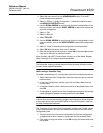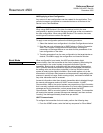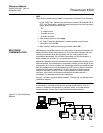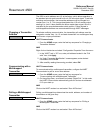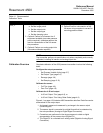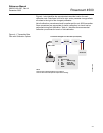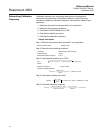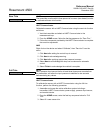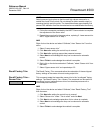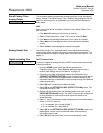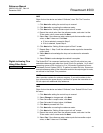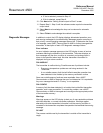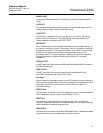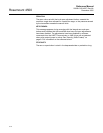
Reference Manual
00809-0100-4027, Rev AA
December 2005
4-5
Rosemount 4500
Choosing a Trim
Procedure
To decide which trim procedure to use, you must first determine whether the
analog-to-digital section or the digital-to-analog section of the transmitter
electronics need calibration. Refer to Figure 4-1 and perform the following
procedure:
1. Connect a pressure source, a HART Communicator or AMS, and a
digital readout device to the transmitter.
2. Establish communication between the transmitter and the HART
Communicator.
3. Apply pressure equal to the upper range point pressure.
4. Compare the applied pressure to the Process Variable (PV) line on the
HART Communicator On-line Menu or the Primary Variables screen in
AMS.
a. If the PV reading does not match the applied pressure (with
high-accuracy test equipment), perform a sensor trim.
5. Compare the Analog Output (AO) line, on the HART Communicator or
AMS, to the digital readout device.
a. If the AO reading does not match the digital readout device (with
high-accuracy test equipment), perform an output trim.
Sensor Trim Trim the sensor using either full or zero trim functions. Trim functions vary in
complexity and are application-dependent. Both trim functions alter the
transmitter’s interpretation of the input signal.
Zero trim is a single-point adjustment. It is useful for compensating for
mounting position effects and is most effective when performed with the
transmitter installed in its final mounting position. Since this correction
maintains the slope of the characterization curve, it should not be used in
place of a full trim over the full sensor range.
When performing a zero trim, ensure that the equalizing valve is open and all
wet legs are filled to the correct levels.
NOTE
Do not perform a zero trim on 4500 Absolute pressure transmitters. Zero trim
is zero based, and absolute pressure transmitters reference absolute zero. To
correct mounting position effects on a 4500 Absolute Pressure Transmitter,
perform a low trim within the full sensor trim function. The low trim function
provides a “zero” correction similar to the zero trim function, but it does not
require zero-based input.
Full trim is a two-point sensor calibration where two end-point pressures are
applied, and all output is linearized between them. Always adjust the low trim
value first to establish the correct offset. Adjustment of the high trim value
provides a slope correction to the characterization curve based on the low
trim value. The factory-established characterization curve is not changed by
this procedure. The trim values allow you to optimize performance over your
specified measuring range at the calibration temperature.



